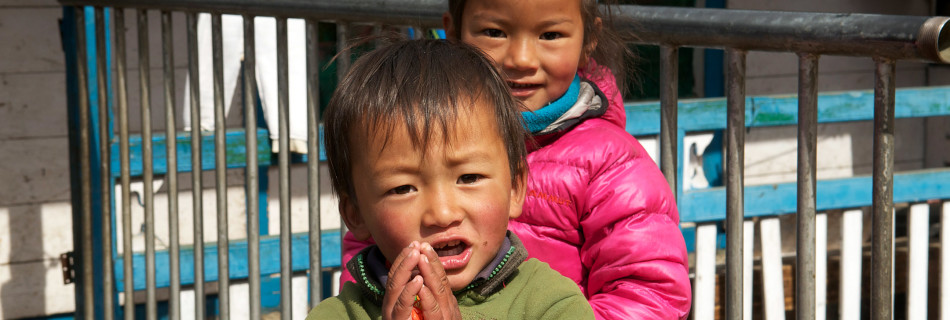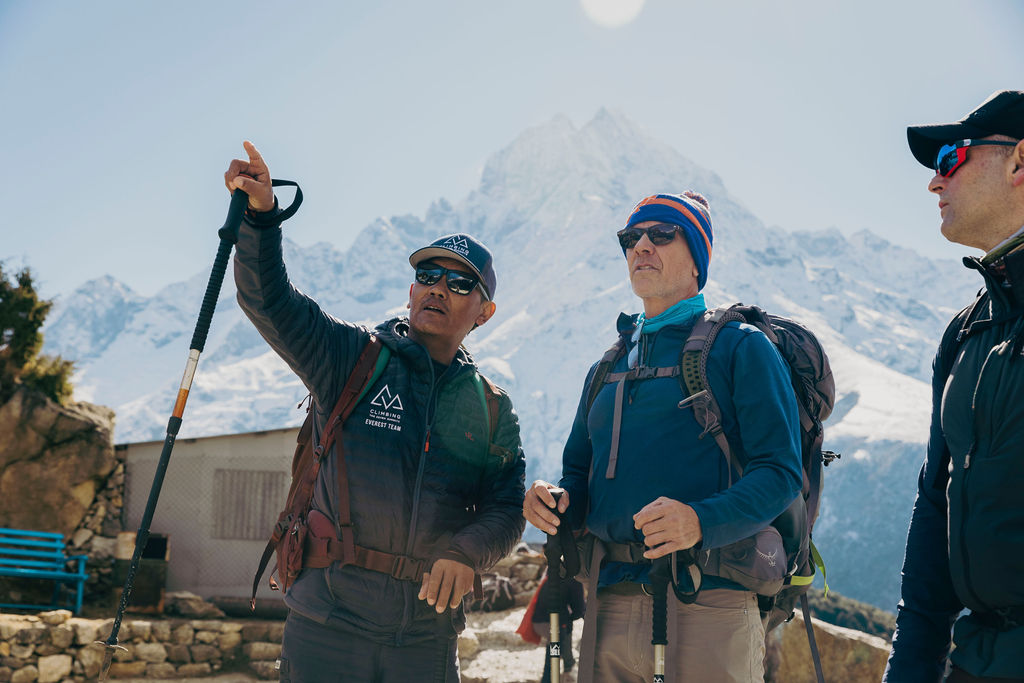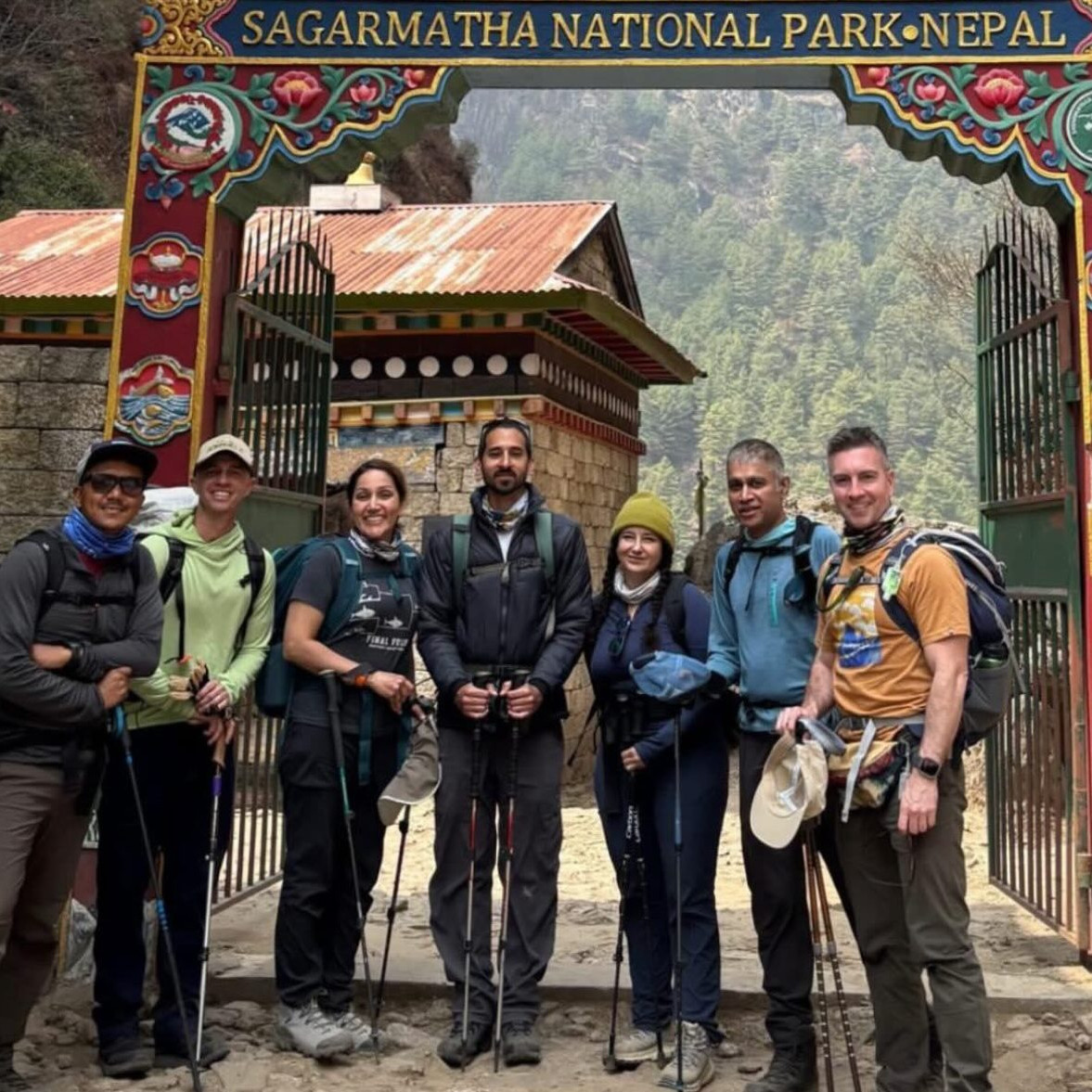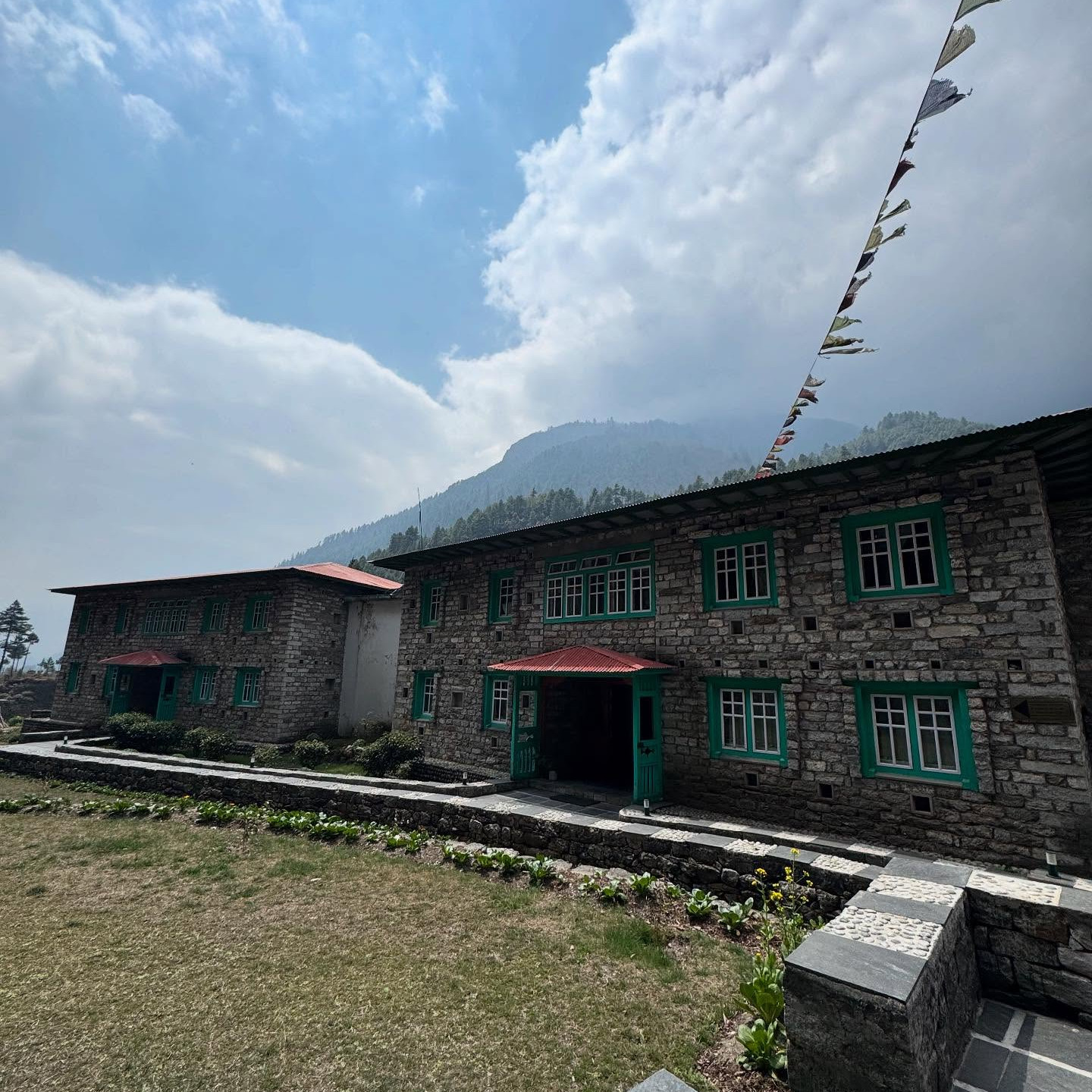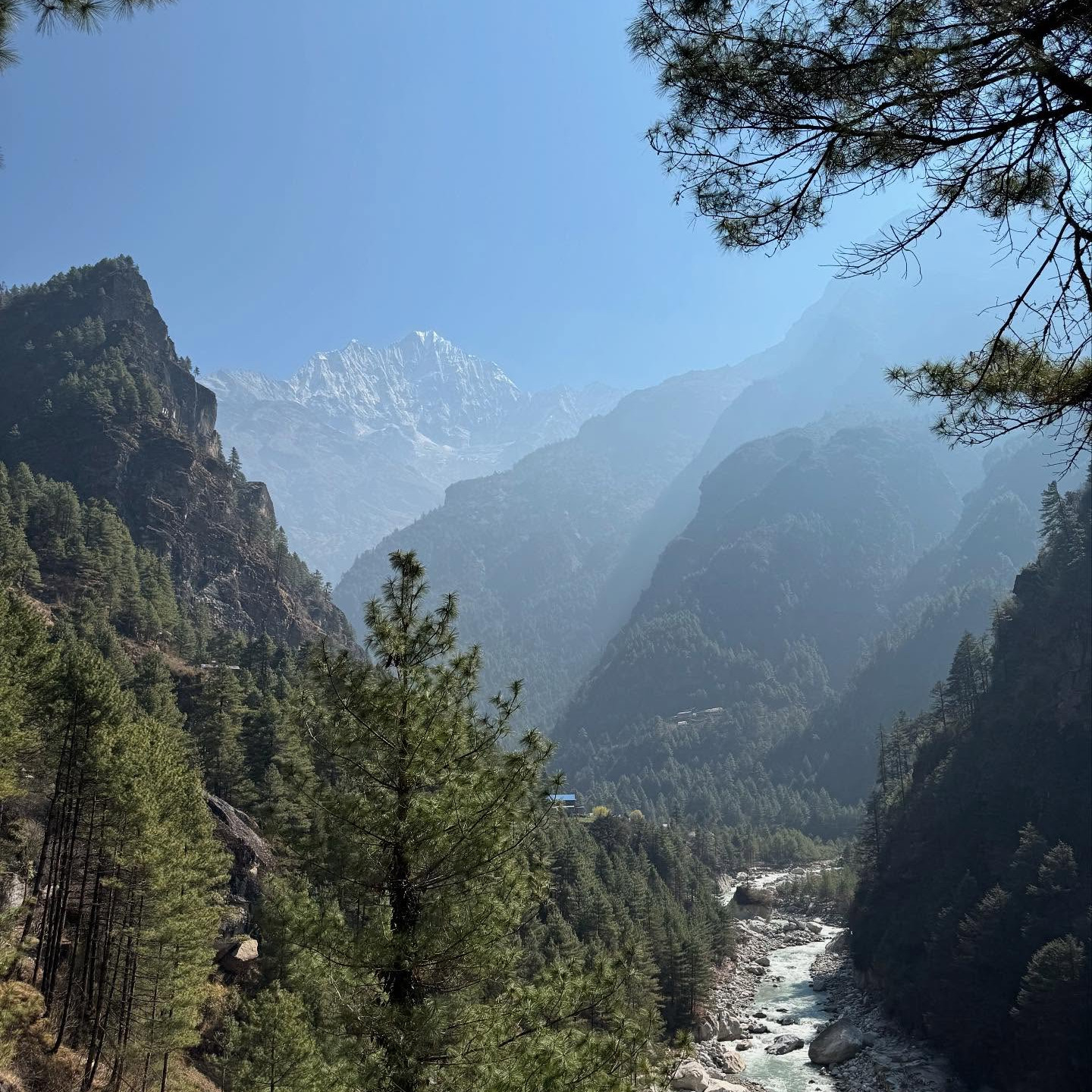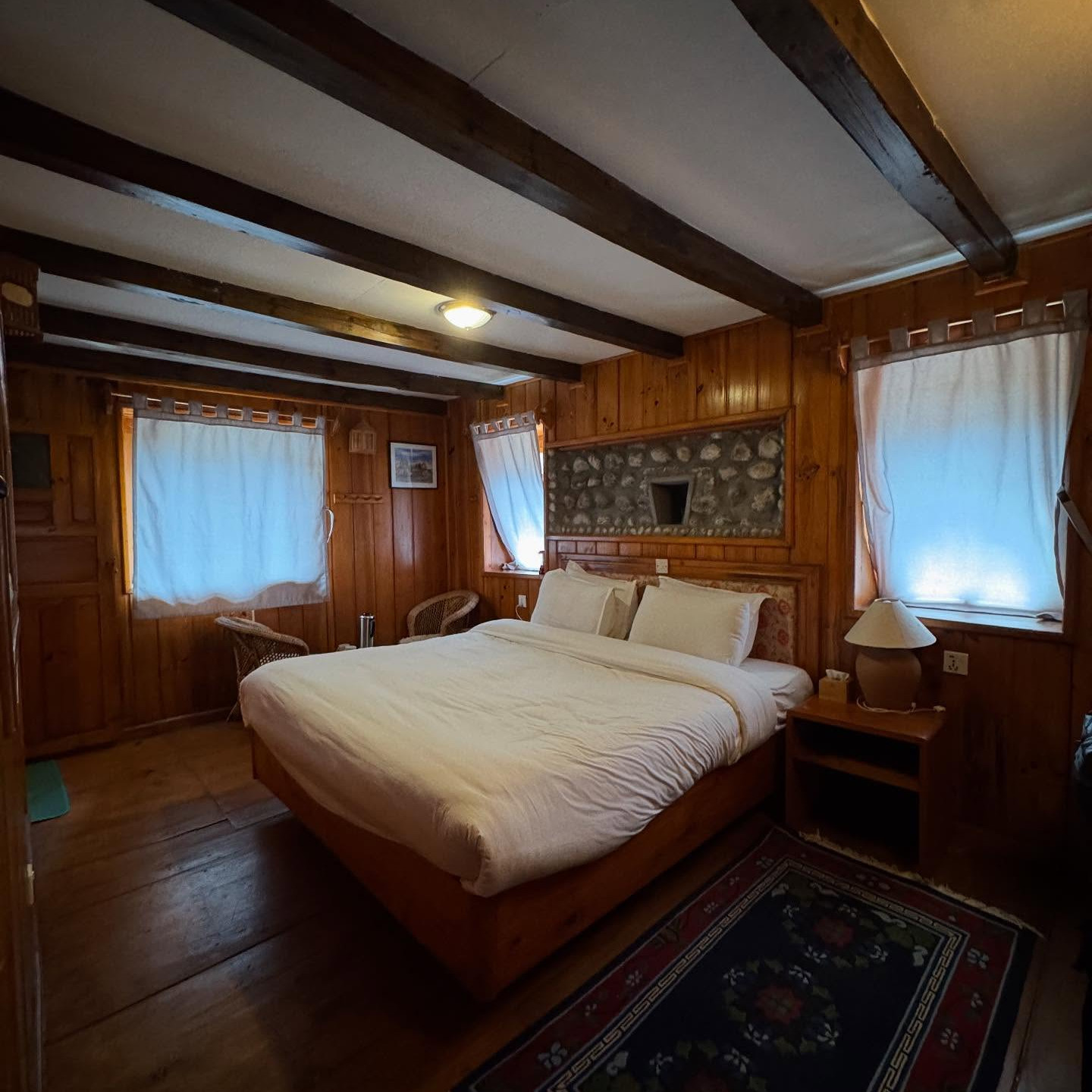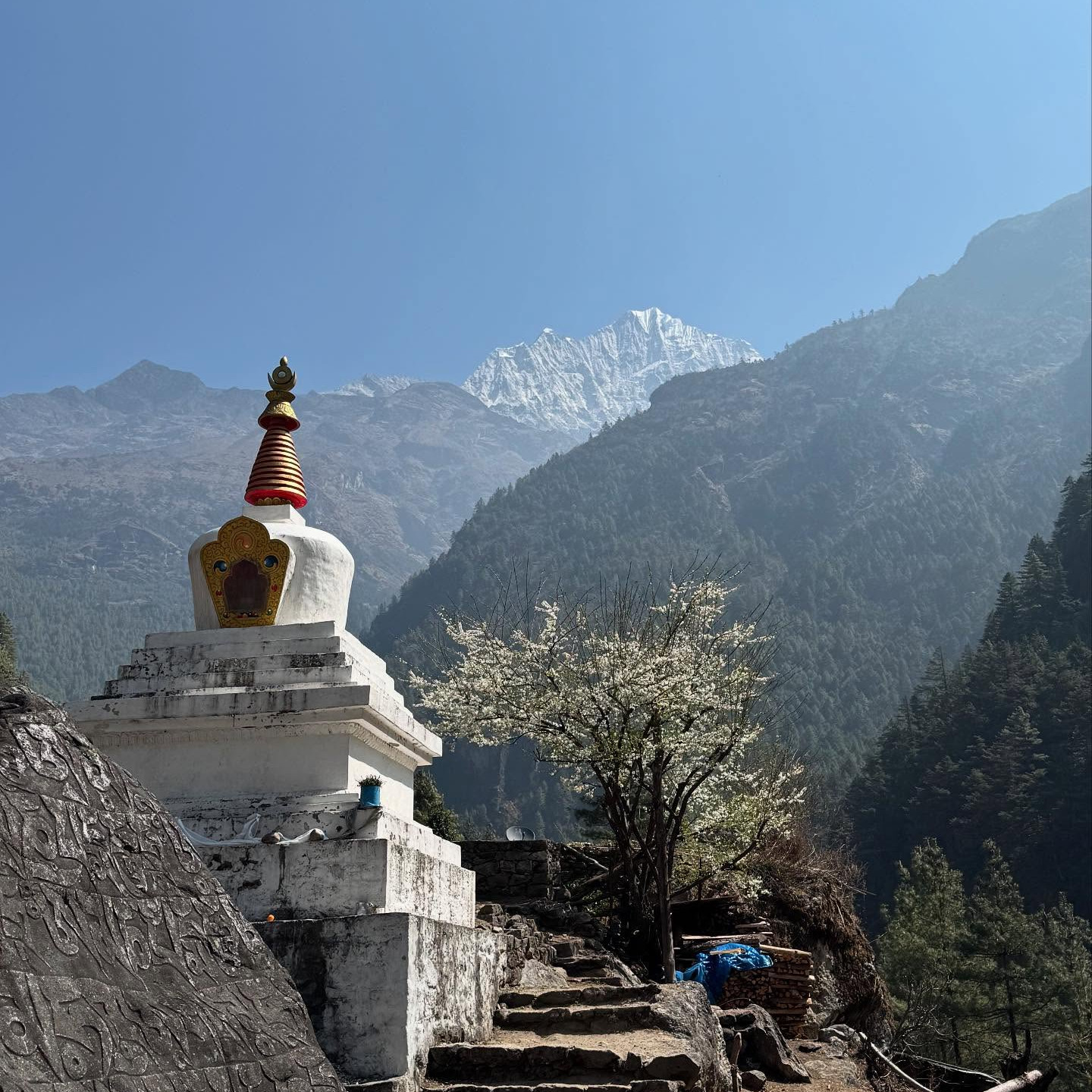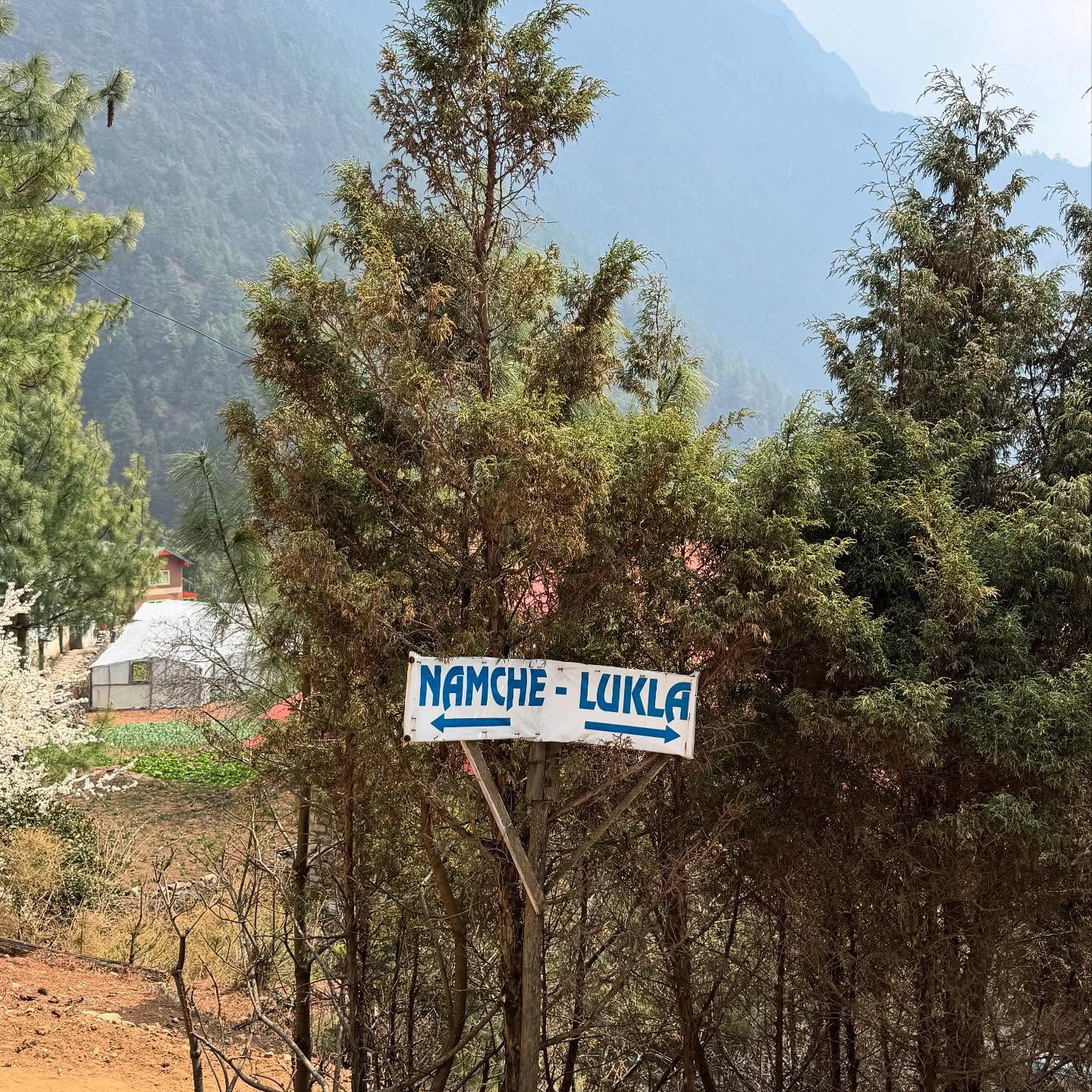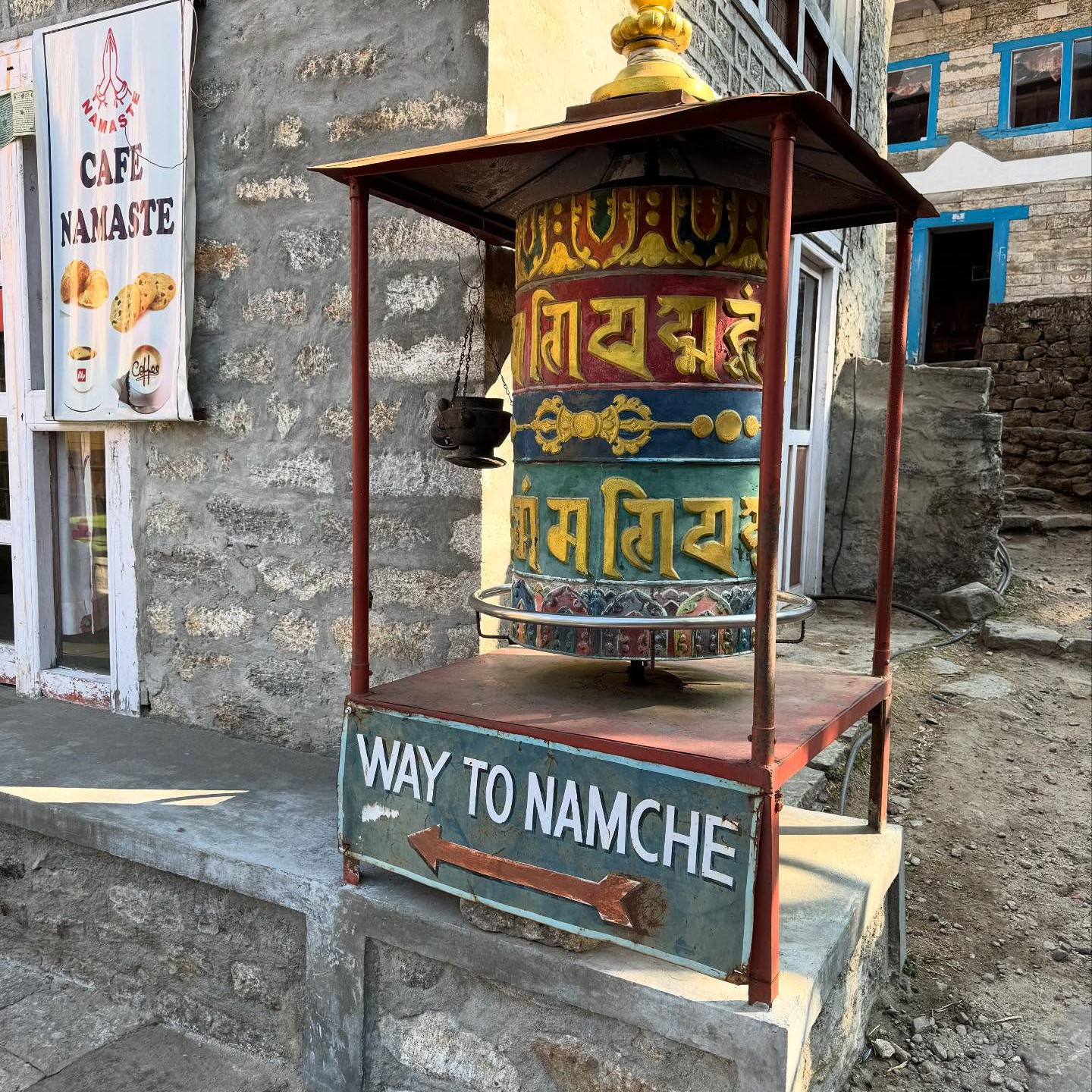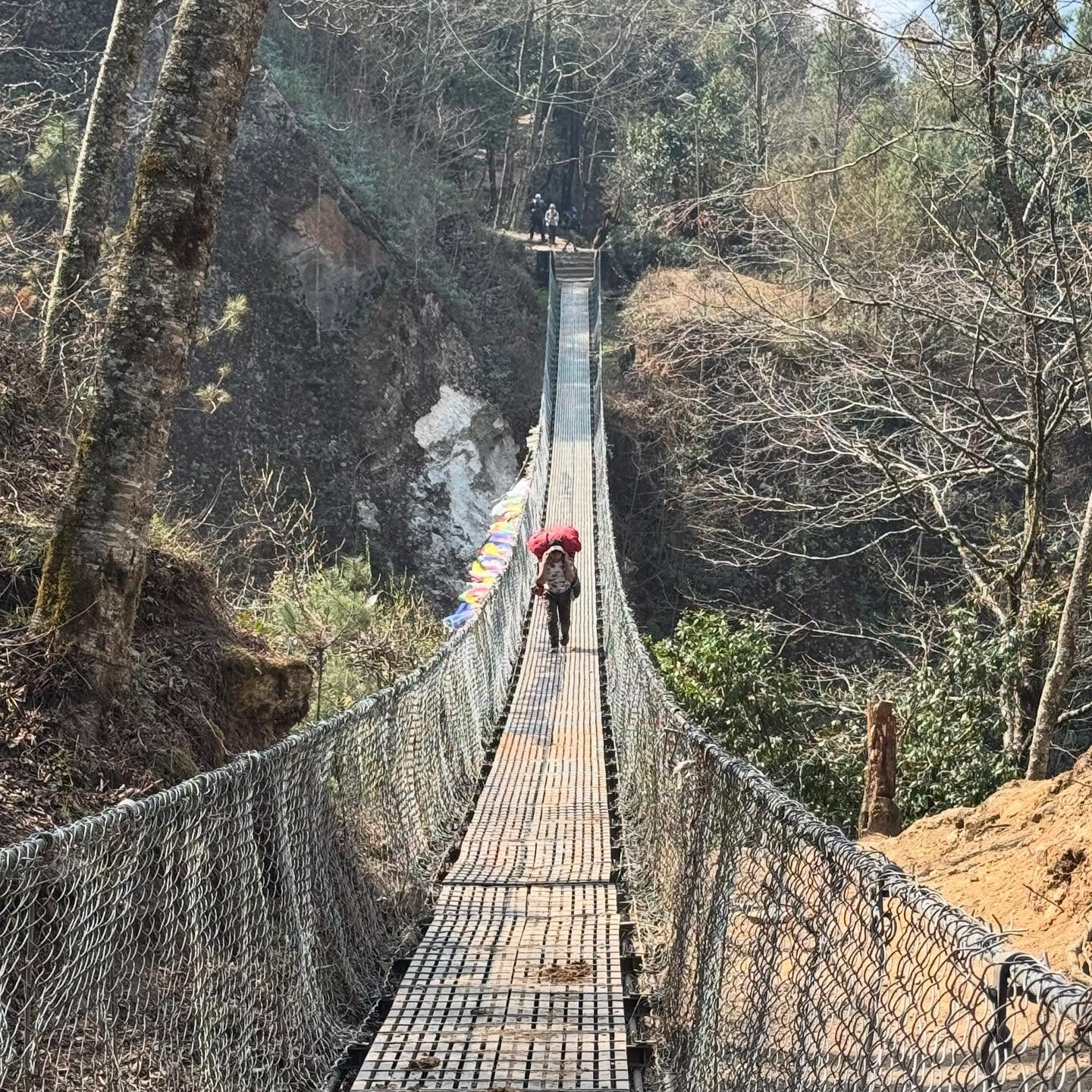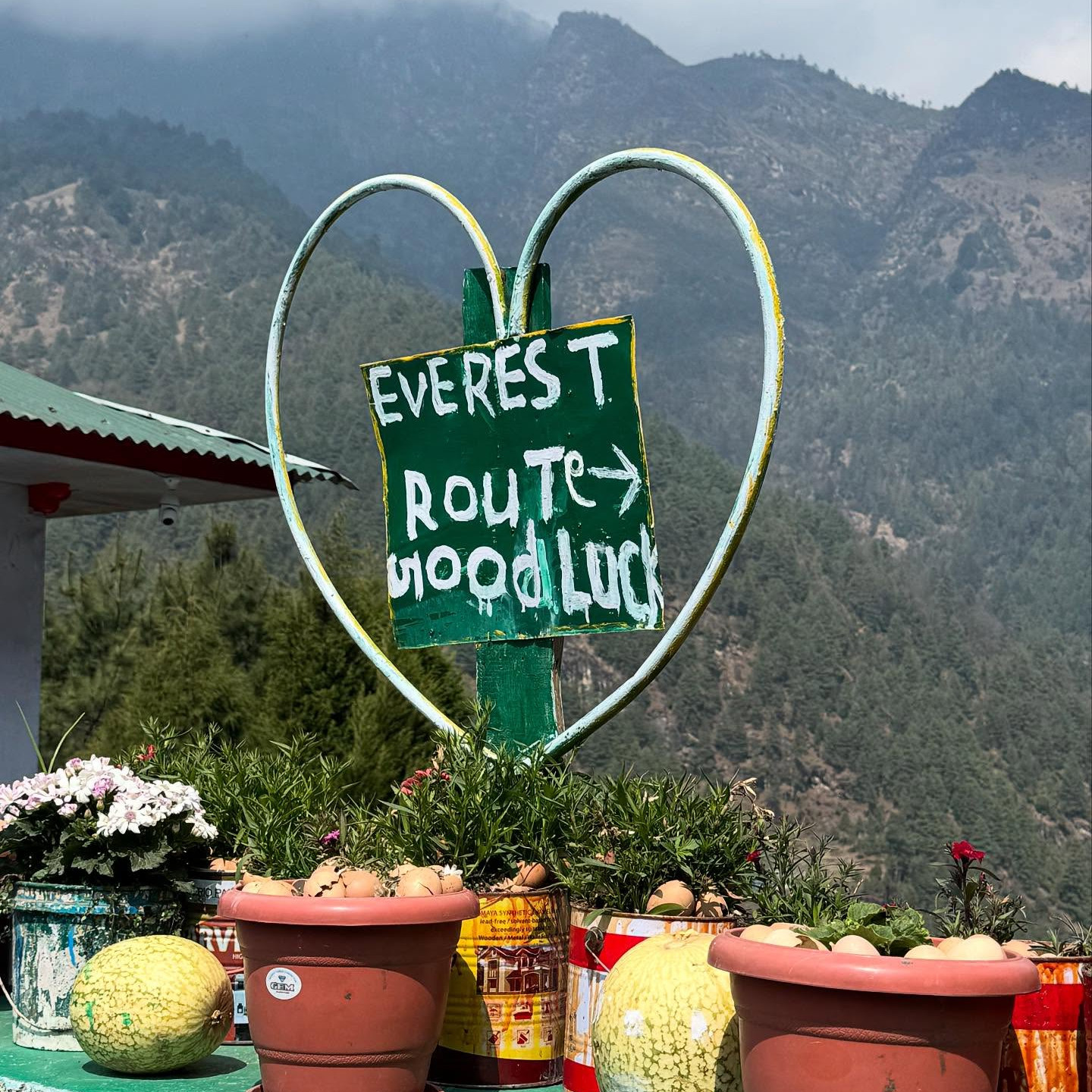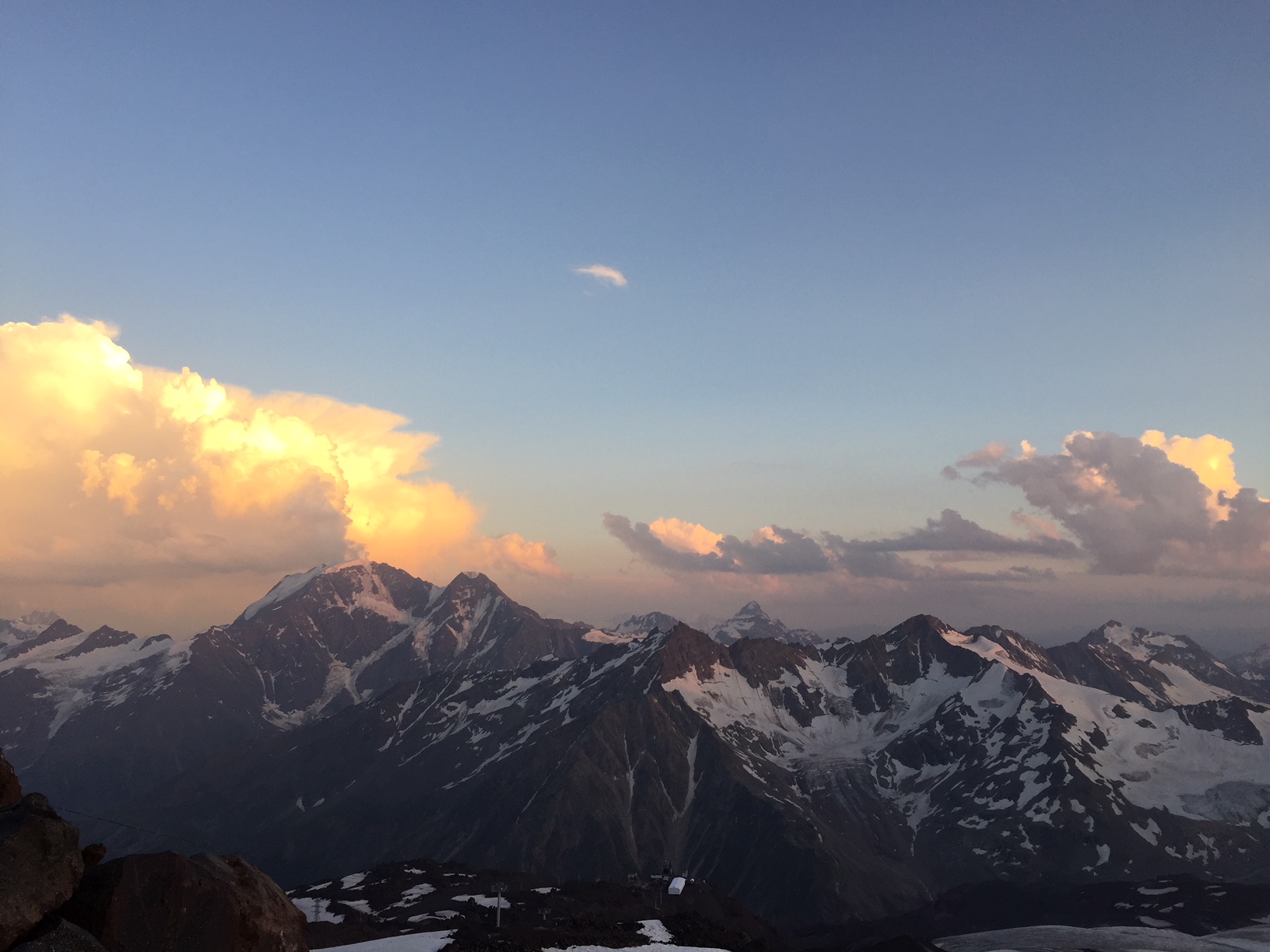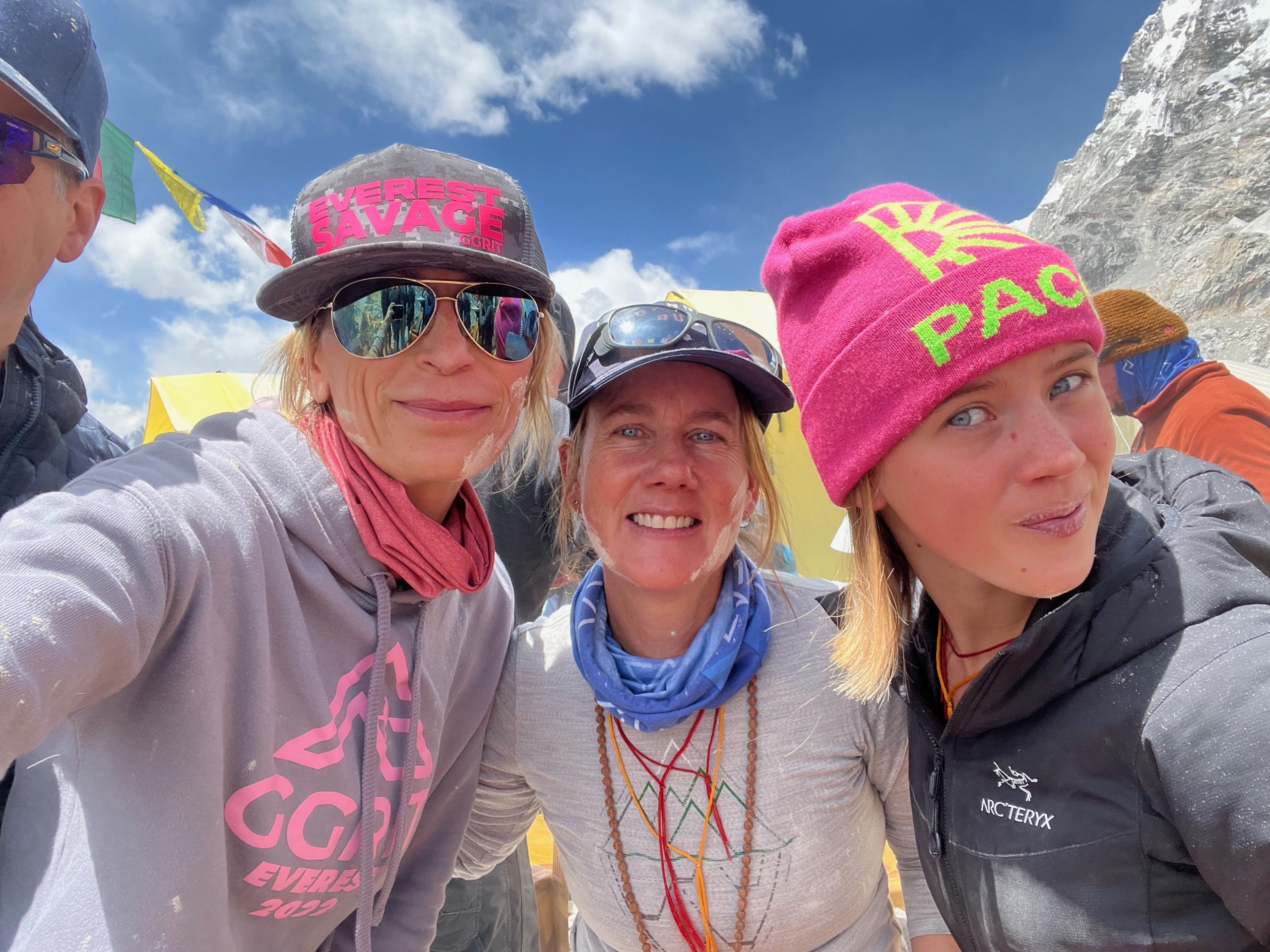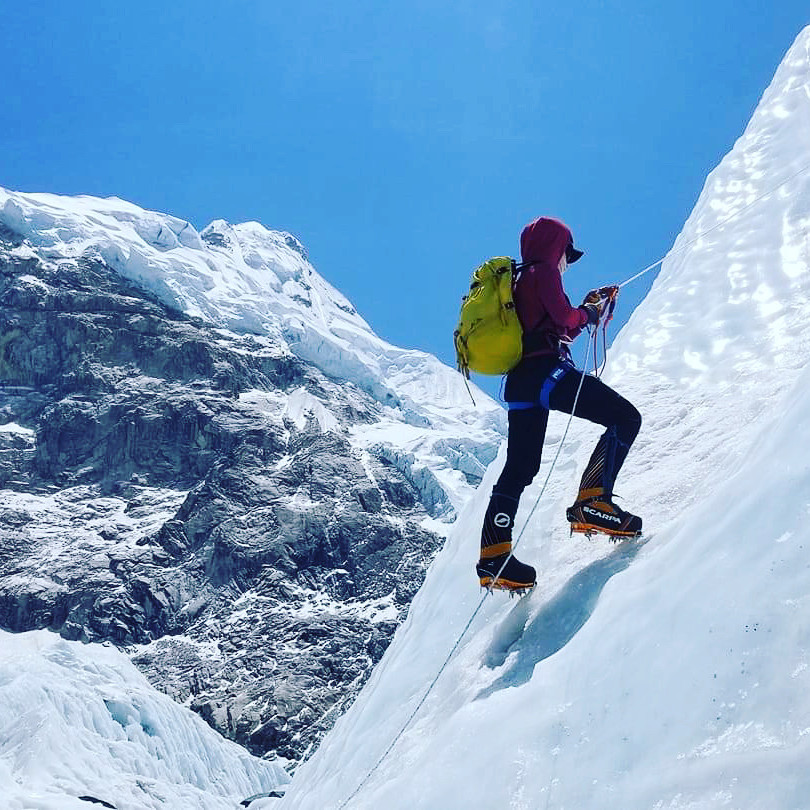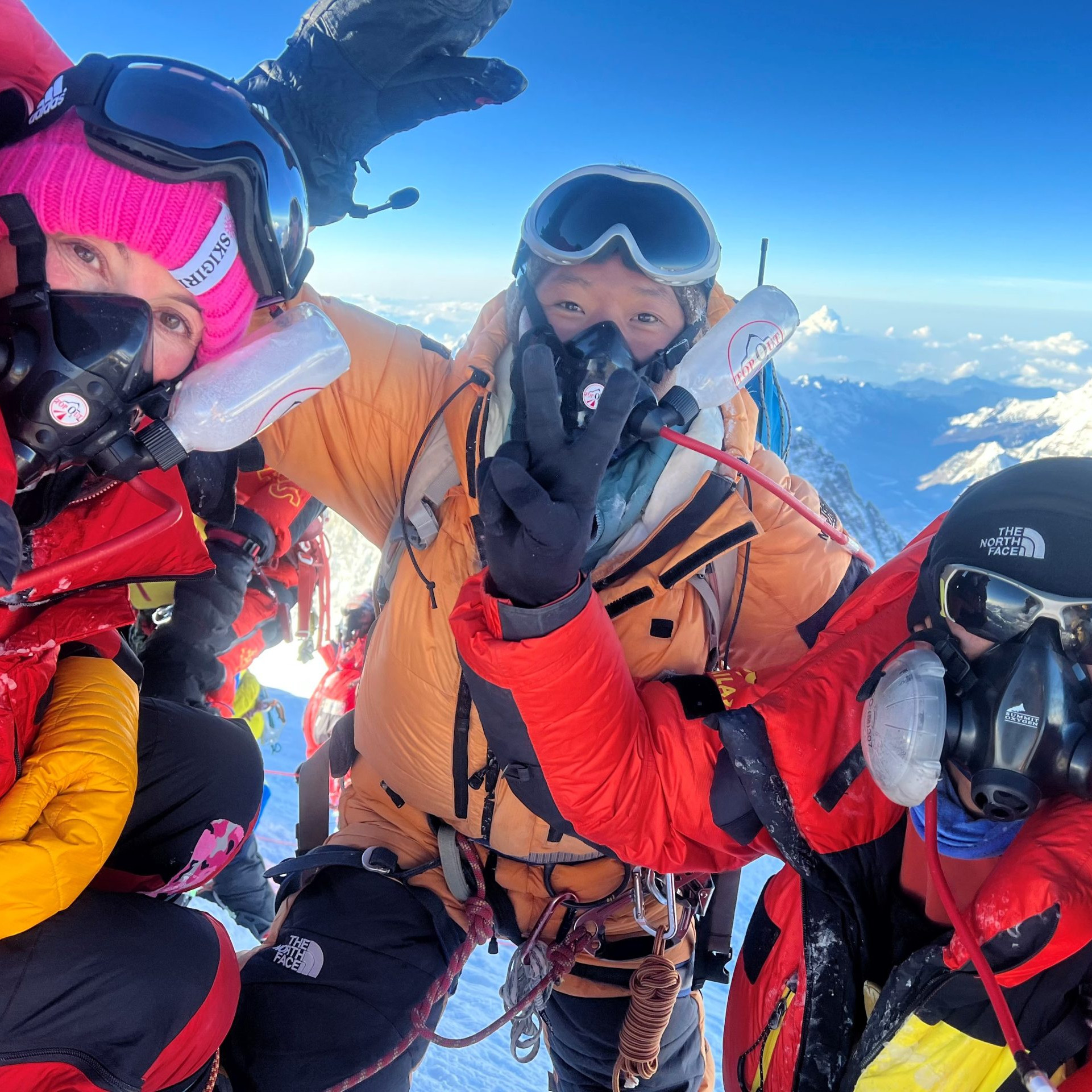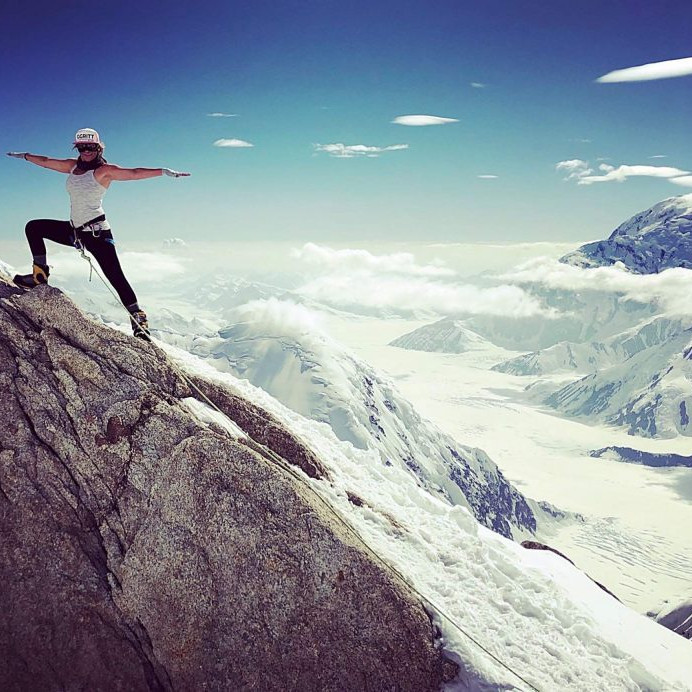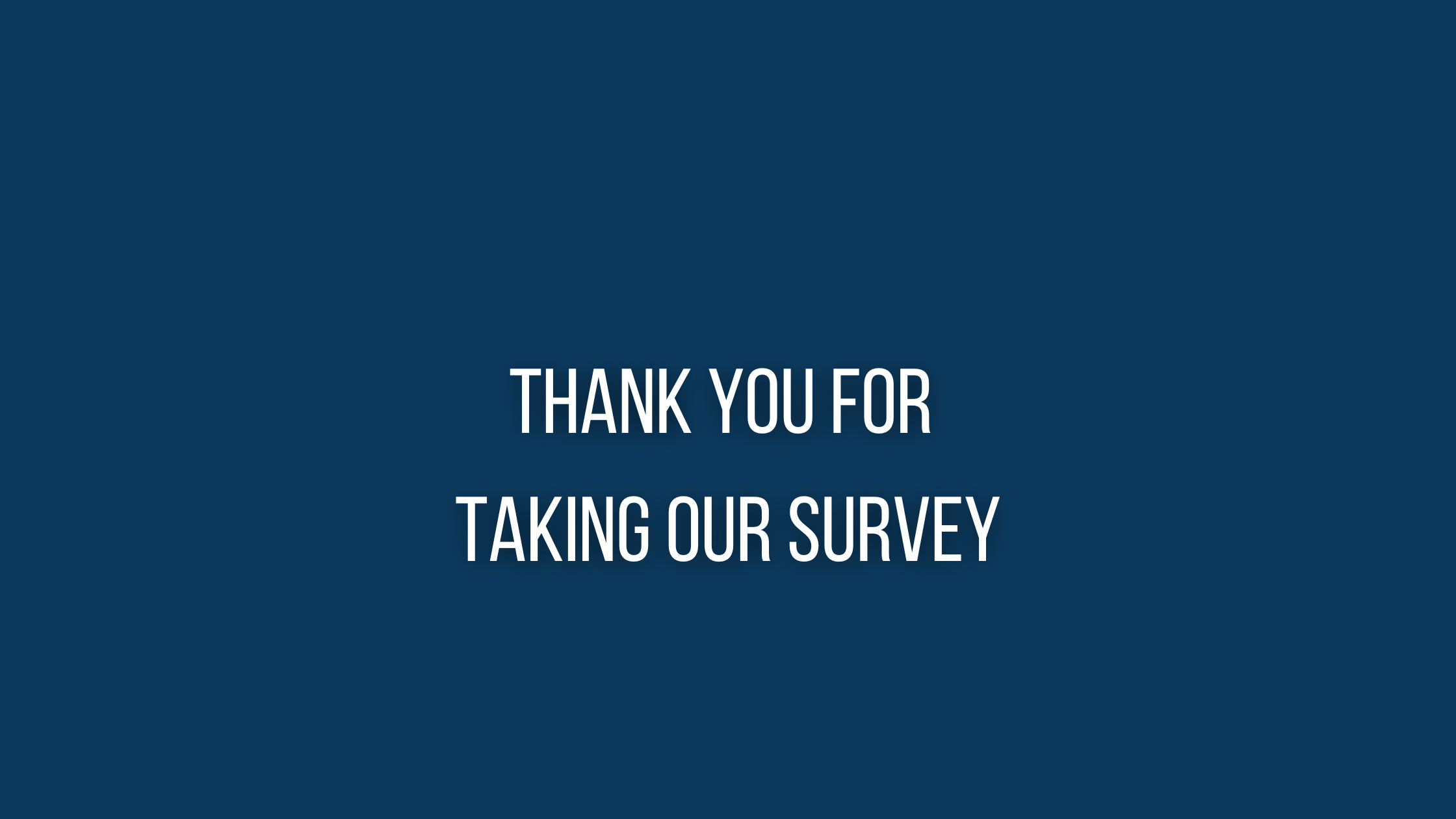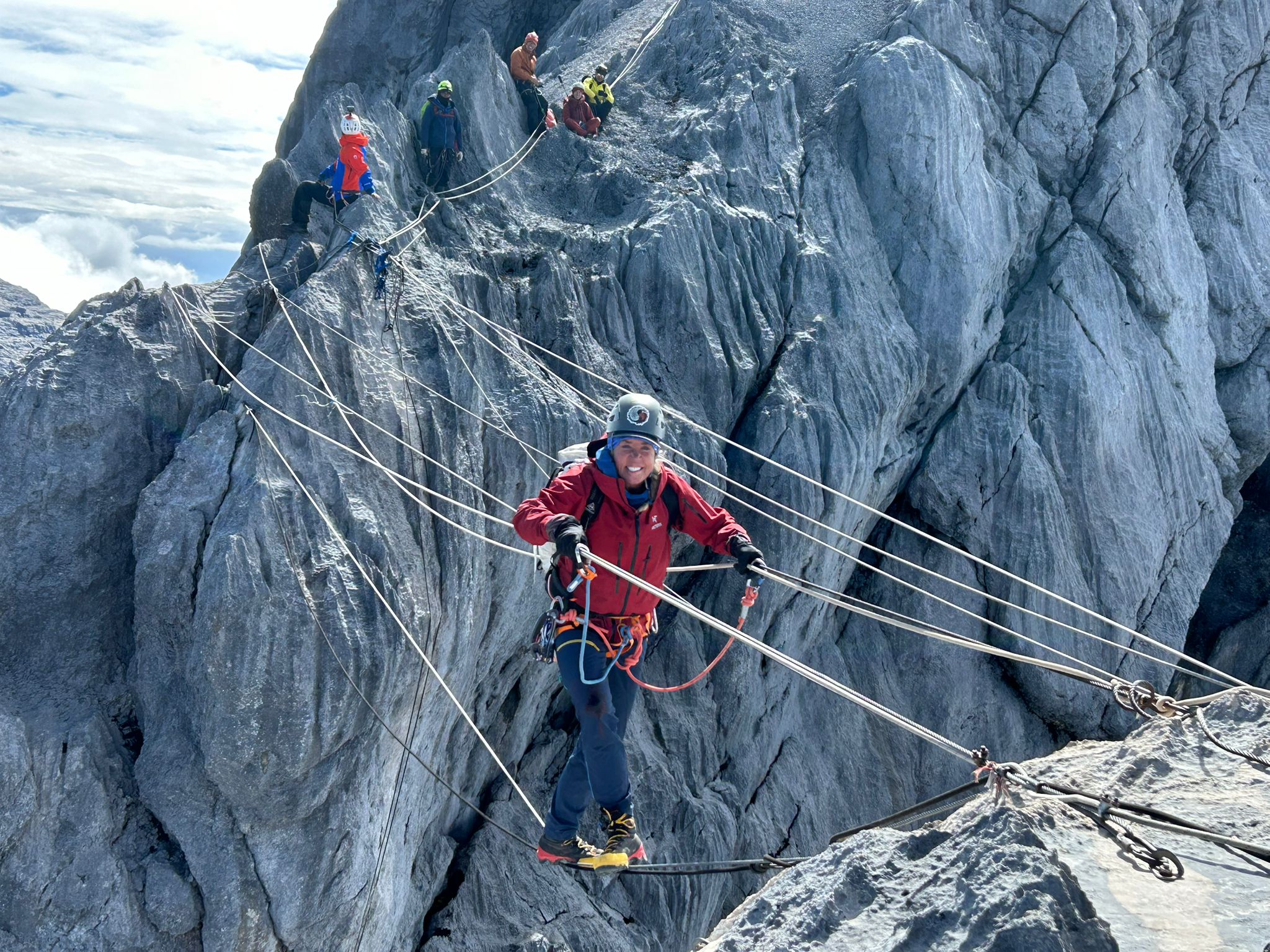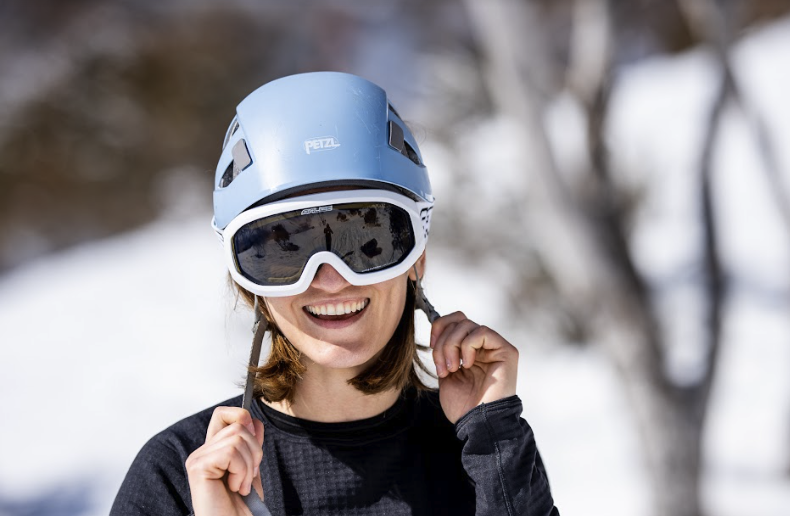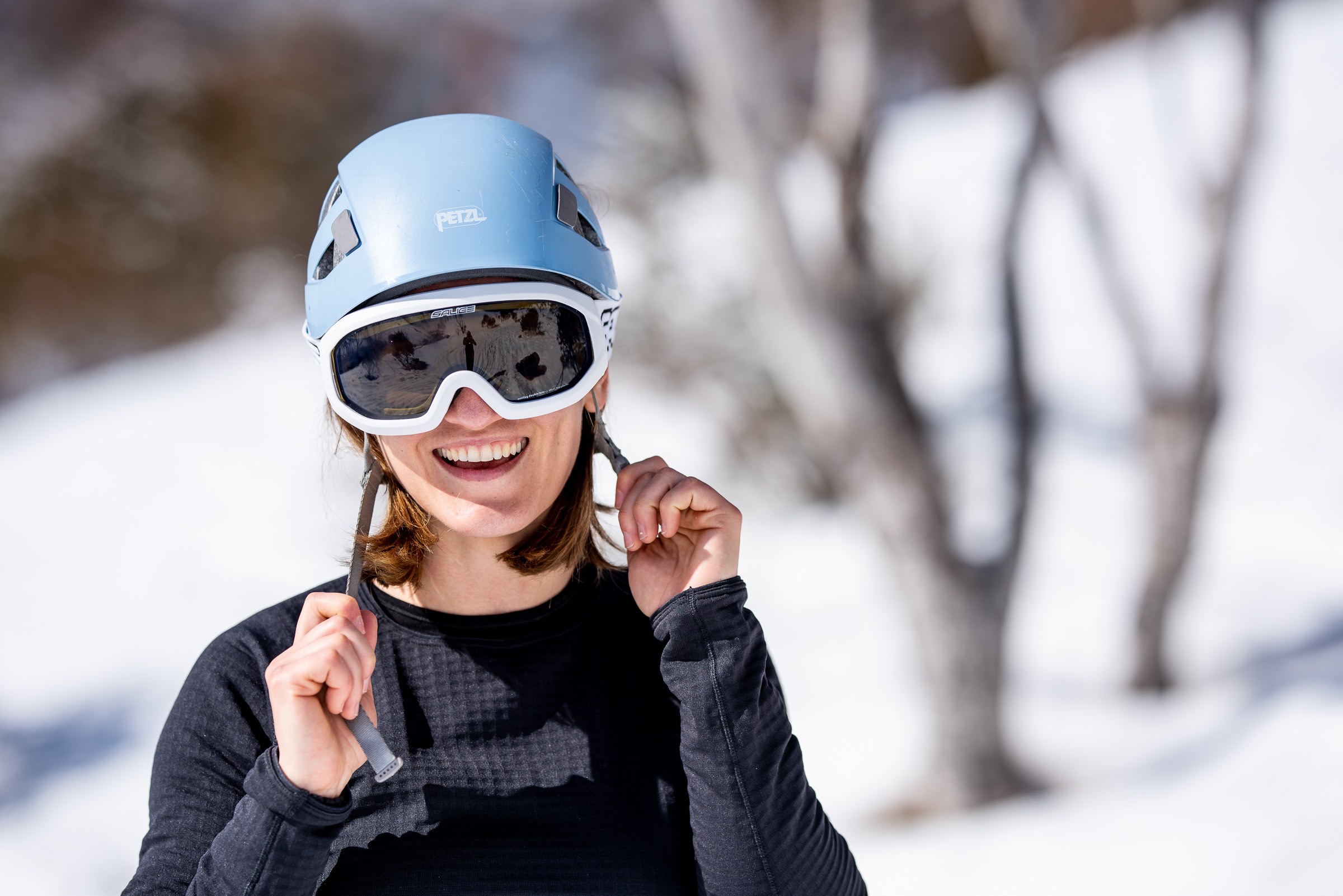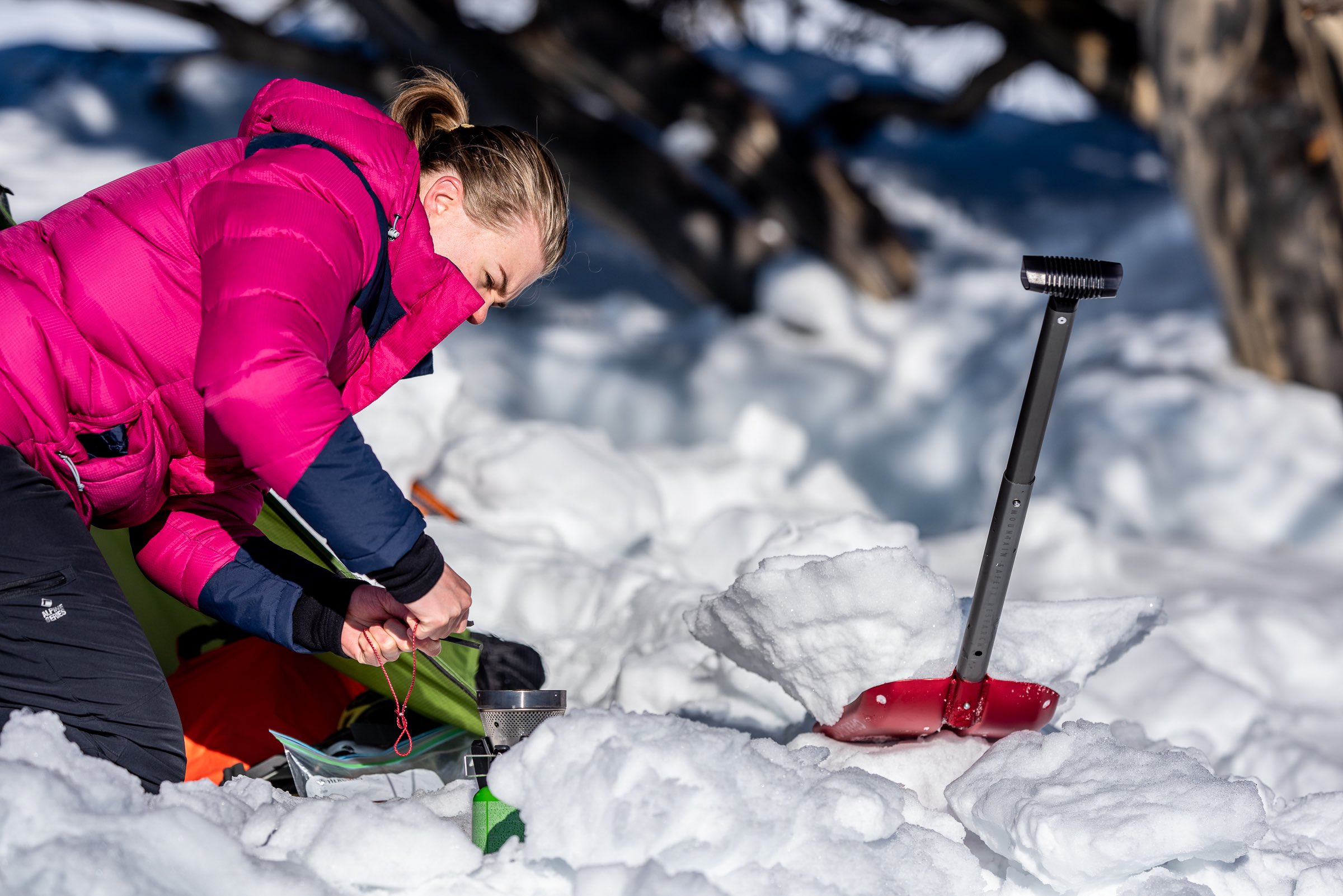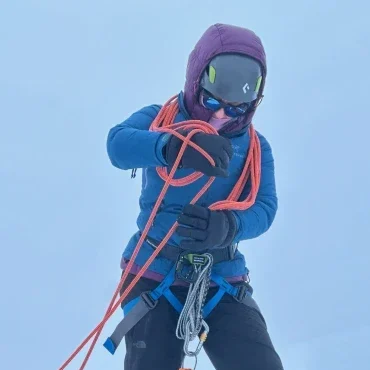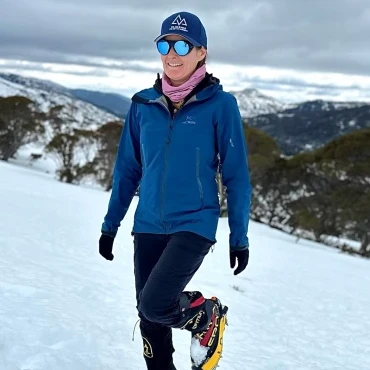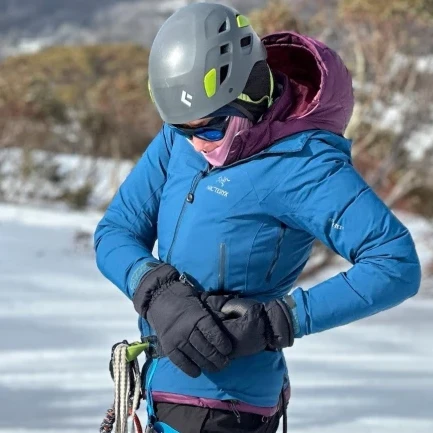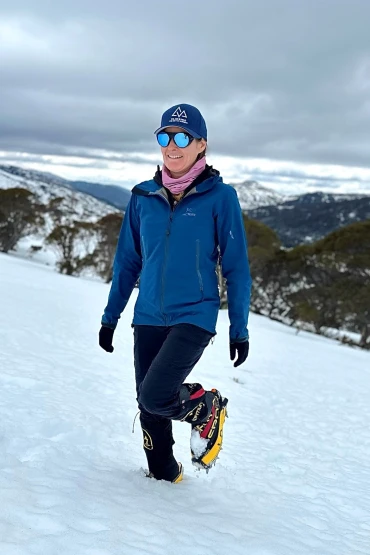An Update from Tiger of the Snows Fund
CTSS owner Mike Hamill received a Khata scarf from Yandi on behalf of Tiger of the Snows Fund (CTTS’s non-profit arm) and all of our climbers and trekkers who have graciously donated to this organization.
Yandi lost her husband to a heart attack on Mount Everest several years ago, and since he was the primary breadwinner, she had no way to pay for her three daughters’ education. Luckily, Ang Pasang and Tendi Sherpa connected us with Yandi, and the Tiger of the Snows fund was able to step in to offer educational support to all three of her children. Since they live in a remote village, Yandi’s daughters go to school in a village far from their house and can only make the long trek home to see their mother when they have a week or more off from school. All three young women are incredibly dedicated to their studies and are getting excellent marks in school, which their mother is very proud of!
Mike shared with the CTSS team what an honor it was to receive the scarf from Yandi while he was in Kathmandu. These moments help bring things full circle for our team and, hopefully, for all of you. Our deepest gratitude goes out to everyone who climbs and treks with CTSS because you help fund TOTS, making this type of support possible. This Khata is yours.
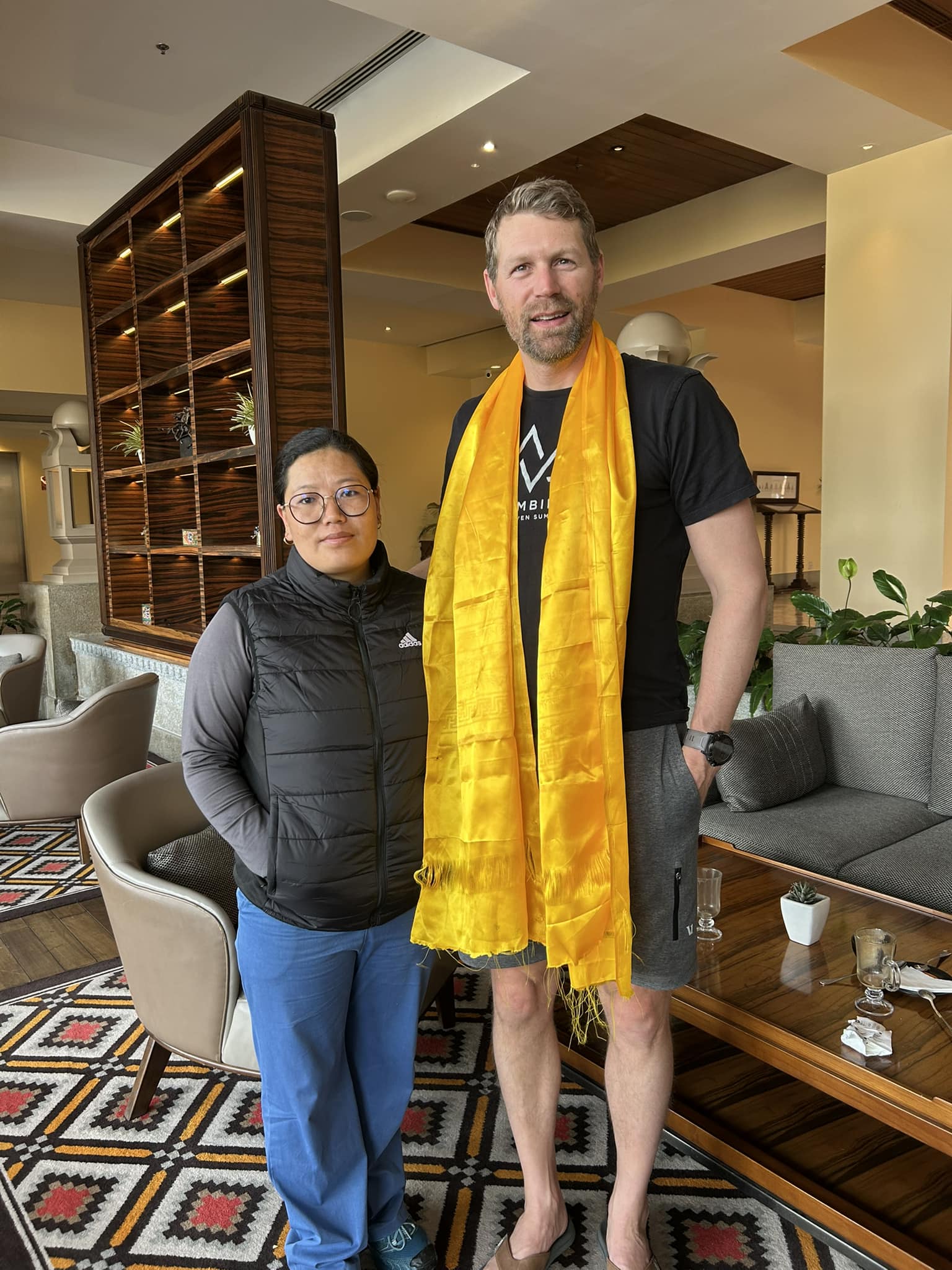
The Himalayan Spring Climbing Season is ON!
The Himalayan spring climbing season has arrived, and we’re kicking things off with one of our favorite treks–in classic CTSS style. Our first group of Rugged Luxury Everest Base Camp trekkers have started their way up the Khumbu Valley after arriving in Kathmandu for a guide briefing, gear checks, and a team dinner at the renowned Le Sherpa restaurant.
This group is led by Everest summiteers Walter Hailes and Pega Sherpa. Once the team touched down in Lukla, they made their way to Phakding for their first day of trekking. Day two took the team to Namche Bazaar, the Sherpa capital of the world. Check out a few of the photos from the team below, courtesy of Nicole Porto. Stay tuned for more; our second wave of Rugged Luxury trekkers arrive in Kathmandu tomorrow!
We want to extend our warmest welcomes to all of our trekkers and climbers and those loving families and friends following along.
Elbrus Expedition Beta & Route
Elevation: 5,642m or 18,510ft
Duration: 12 Days
Continent: Russia
Route: Southside Route
Difficulty: Beginner
Special Considerations: Russian tourist visas need to be secured in advance and can take time for you to organise so it is important to commit to Elbrus as early as possible.
Route Choice
We have chosen the Southern climbing route to give you the best chance of summiting Mt. Elbrus. This is known as the “trade route” on the mountain and rightfully so. It offers the least technical climbing and a minimum of crevasse hazards en route to the top.
All of our expeditions incorporate a slow acclimatization schedule giving you the best chance of summiting without experiencing altitude illness, and are organized by world renowned guide and expeditions leader, Mike Hamill. More than 150 climbers have stood atop Mt. Elbrus under Mike’s direct guidance.
Every expedition originates in St. Petersburg where we explore this colorful city before flying to Mineralnye Vody in the Elbrus region.
Once in the Elbrus region we will spend several days acclimatizing based out of our mountain Chalet while enjoying the local cuisine. We then move up to our mountain hut and make a summit bid after a few days of acclimatization. If we summit on time we will use our contingency days to relax back down in the valley, exploring, horse riding, and enjoying Russian Banya before flying to Moscow.
Here in the largest city in Russia, we will tour Red Square, the Kremlin, see St Basil’s Cathedral and visit various other sights of historic importance. We then transfer to the airport to start our journey home. You are welcome to extend your trip should you wish.
Climbing Mt. Elbrus requires solid fitness, an ability to perform well at altitude, the mindset to be away from home for several weeks, and a desire for rugged adventure travel. The Caucasus region of Russia is still a remote and rugged place off the beaten path an is true adventure travel. When away from the major cities don’t expect lattes and blazing fast internet. We will be traveling on glaciated terrain with crampons, harnesses and ice axes and clipping in to fixed ropes. Not to worry if you haven’t done these skills before as we will lead you through a complete snow and climbing school as one of our acclimatization days prior to the summit bid.

Managing Nature’s Call on Everest: Down Suits for Women
Managing Nature’s Call on Everest: Down Suits for Women
Let’s face it: being a woman in the mountains brings unique challenges—and using the bathroom is high on that list. Now, add being tucked into a down suit in the death zone on Everest, and the question becomes, how do you go to the bathroom? More importantly, what features should your down suit have to make this process as smooth as possible?
We sat down with Seven Summits summiteer Meghan Buchanan, who shared some practical advice for women based on her wealth of experience facing this reality in extreme conditions. When it comes to down suits, the type of zipper can make all the difference. Meghan’s insights on the pros and cons of two common options can help you decide what works best for you. Here’s what we learned:
Half-Moon or Rainbow Zipper:
This style of suit has a half-moon-shaped zipper on the seat of the pants. Sometimes, this style is called a rainbow zipper; both names are a reference to the shape it takes on your down suit. This style allows you to fully unzip the seat of your suit and drop the extra material to your knees with ample room to squat and use the bathroom.
Half-Moon Down Suits We Love:
- Feather Friends Expedition Down Suit (drop-seat rainbow zipper)
- Mountain Hardwear Women’s Absolute Zero Suit (rainbow rear-zip)
- The North Face Women’s Himalayan Suit (rainbow drop-seat)
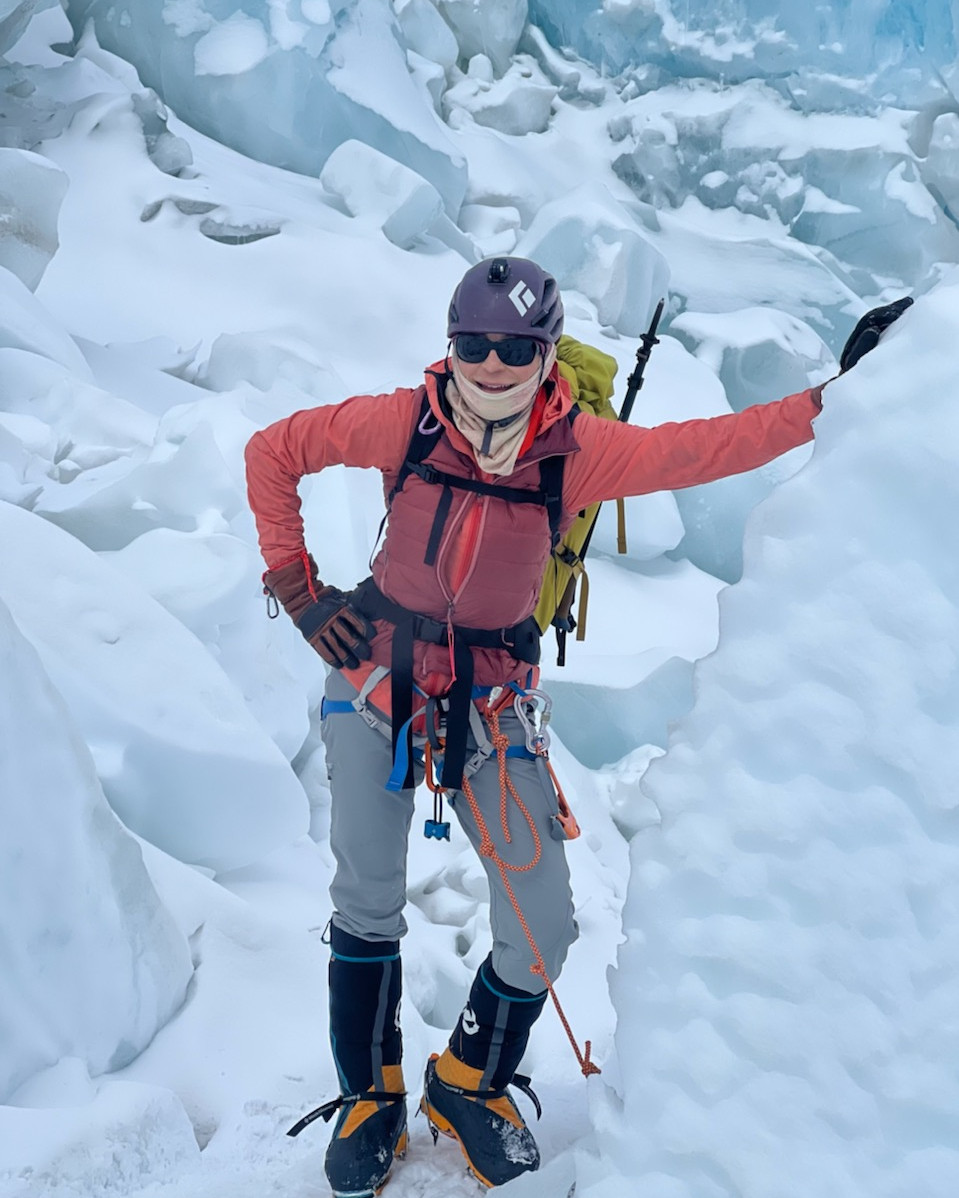
- Easy to unzip and re-zip
- Provides ample wiggle room to pull down the rest of your pants
- Simplifies the management of other layers
- Extra material or flap can get in the way
- Careful attention is required to avoid mishaps
- Limited compatibility with pee funnels unless the suit has a front zipper
Zip-Through Zipper:
This style of suit has a zipper that goes from the front to the back of your pants along the middle seam between your legs. You will find a variety of product descriptions and names, like the RAB two-way front zip and the Gnara GoFly zipper, but all are a reference to the placement of the zipper on your down suit. This style allows you to unzip the inseam of your suit and either squat down or use a pee funnel to use the bathroom.
Zip-Through Products We Love:
- RAB Expedition 8000 Suit (two-way front zip)
- Gnara Go There Pants (hiking pants)
- Gnara Midweight Base Layer Bottoms (base layer)
- Eliminates the hassle of managing extra material while using the bathroom
- Works better with a pee funnel, even without an extra front zipper
- Can be slightly harder to unzip and re-zip
- Can be tricky to access and adjust your other layers
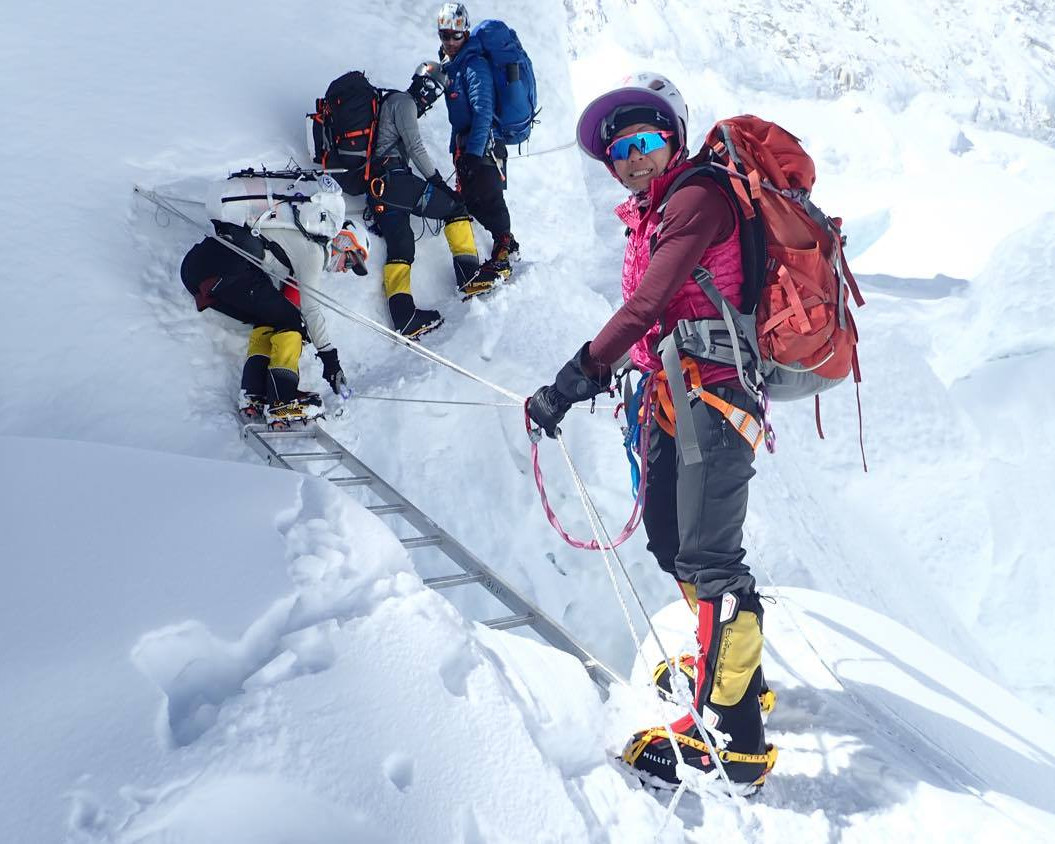
Meghan’s Personal Solution: The Modified Half-Moon
Meghan swears by the half-moon design, which she retrofitted by sewing a loop handle that runs laterally just above the zipper. Here’s the play-by-play on how this works from Meghan:
- Step 1: Unzip your half-moon zipper
- Step 2: Pull the rear material down to an appropriate length
- Step 3: Reach your hand through your legs from the front and grab the loop handle
- Step 4: Gather the extra material towards the front of your body and down suit
- Step 5: If you need both hands, clip the loop handle to your harness or just hold on
- Step 6: Pull down your pants as needed, squat down, and relieve yourself—hooray!
- Step 7: Stand up, release or unclip the loop hand, and rezip your down suit
Meghan’s modification should look something like this ➜
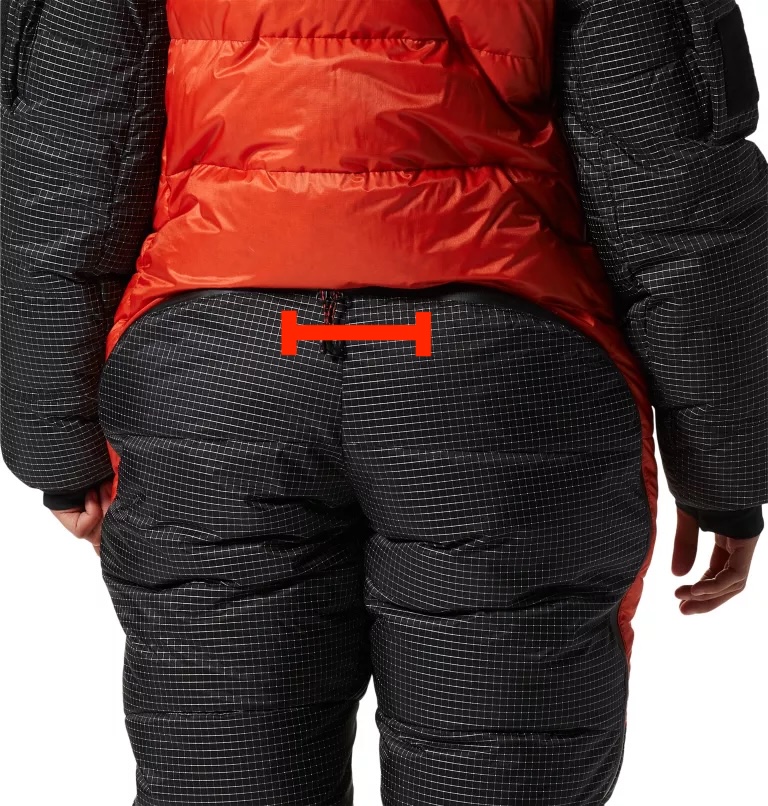
This loop handle lets you keep the extra material, or the flap, out of the way and ensures quick and easy access without removing your harness. Meghan has also been known to clip a carabiner to the loop, which can make it easier to find and hold onto the loop. This method has worked perfectly for Meghan and allowed her to keep things simple when using the bathroom on Everest.
Practical Tips from Meghan:
- Practice Makes Perfect: Meghan’s guide on Denali emphasized the importance of practice. There, Meghan learned to use her pee funnel and practiced while wearing her gear and gloves and even in front of others. Don’t hesitate to practice at home, wearing all of your gear, of course, so you know exactly what to do when you’re on the mountain. By honing these skills, you will ensure you feel confident and efficient when you need them the most.
- Build a Schedule: On extended expeditions, your body becomes a machine. Pay attention to your schedule and plan around it. Knowing your routine helps you anticipate when you’ll need to go to the bathroom and what options you might have.
- Open Communication: Talk to your guides, your team, and even your expedition leaders like Mike Hamill. Don’t be embarrassed, especially as a woman. Open conversations about your needs will ensure that everyone is on the same page.
- Be Prepared: Don’t forget to carry a WAG bag for areas like the Khumbu Icefall. Knowing the terrain will help you be mindful of where and when you can go to the bathroom.
- Keep It Lighthearted: On Meghan’s first group pee experience, her team made sure the environment was fun and supportive, making the whole moment a bit more approachable. Everyone looked away, but they knew what was happening, setting a comfortable tone for the rest of the expedition.
Final Thoughts:
Meghan’s mantra is to take ownership of your needs. Using the bathroom on the side of a mountain as a woman is undoubtedly more complex, but with the right mindset, it doesn’t have to be an obstacle. Meghan encourages everyone to embrace the challenge and not let bathroom logistics hold them back from achieving their goals. Prepare, practice, and communicate; whether you’re tackling Everest or climbing closer to home, take the time to get comfortable with your gear and own your needs.
“Don’t let needing to pee keep you from reaching the next level.”
– Meghan Buchanan
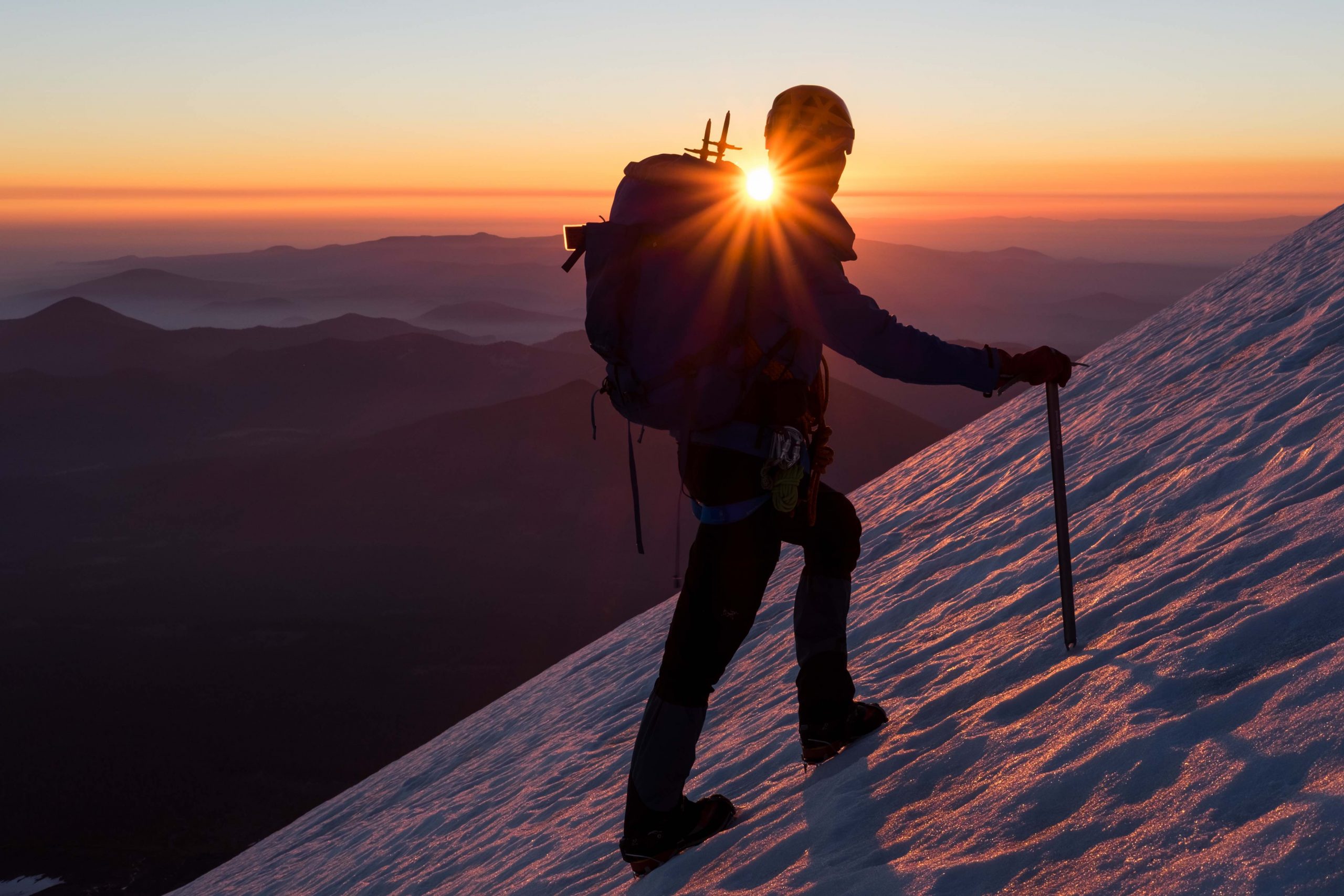
Masters Mountaineering Survey Thank You
Do you have other ideas on how to shape our Masters Mountaineering Program?
Drop us a message below or mail us at info@climbingthesevensummits.com
Climbing the Seven Summits and Charles Darwin University Partner to Protect Mountain Ecosystems
Climbing the Seven Summits and Charles Darwin University Partner to Protect Mountain Ecosystems
At Climbing the Seven Summits (CTSS), we’re committed to providing world-class mountaineering experiences while prioritizing the health and sustainability of the environments we explore and the mountain communities who support us. As part of this commitment, we are excited to announce a new partnership with researchers from Charles Darwin University (CDU) to better understand and mitigate the mountaineering industry’s impact on the ecosystems surrounding the Seven Summits.
Led by CDU Lecturer in Sustainability Leadership and Management Dr. Chrystie Watson—who will climb each of the Seven Summits with CTSS—this long-term project will assess the effectiveness of management strategies, investigate the environmental psychology of mountaineers, and review industry practices. CTSS aims to use the study’s findings to inform how we can not only improve our own practices but promote greater social, economic, and environmental stewardship across the mountaineering industry.
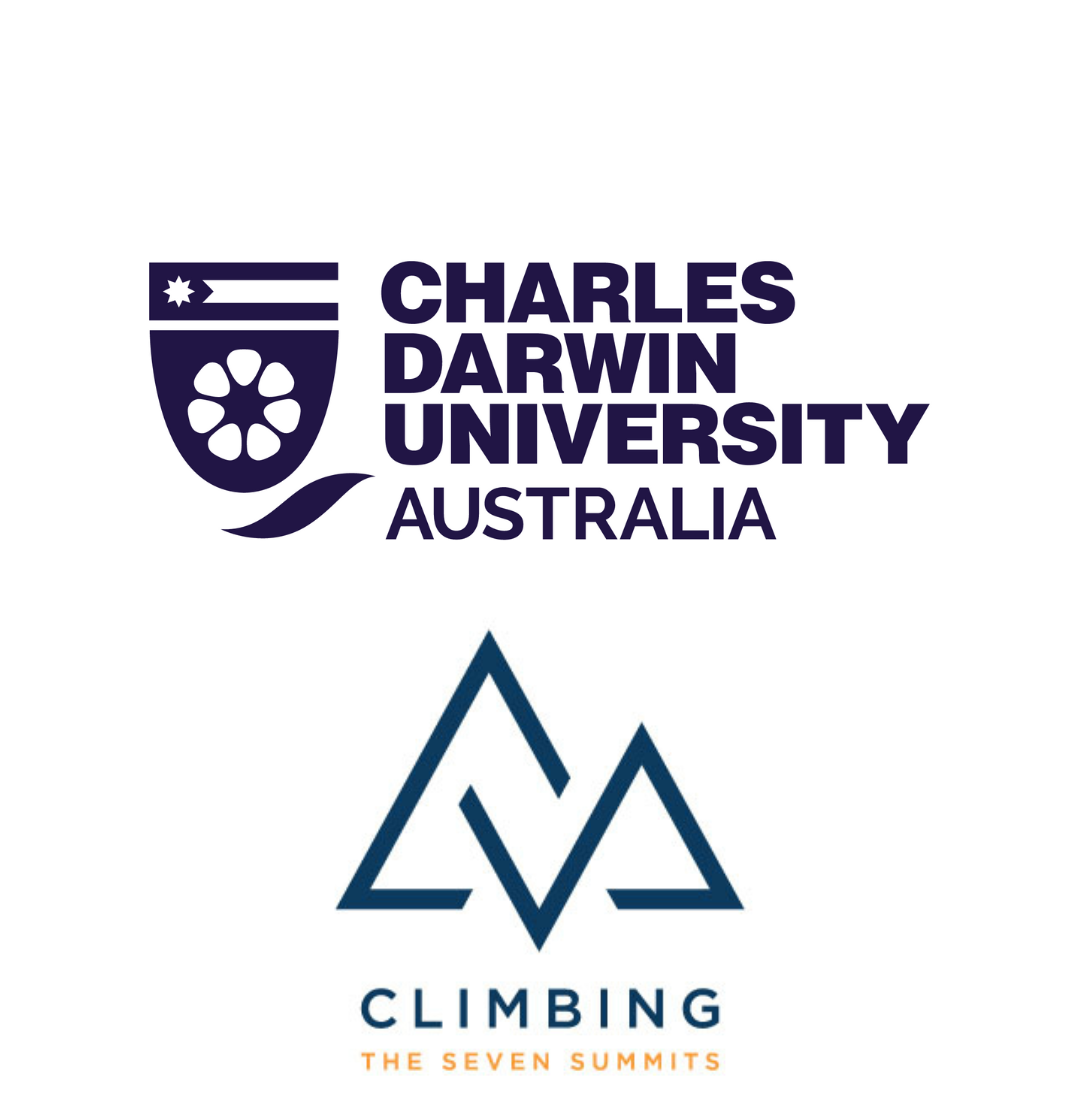
We believe that true adventure is built on integrity—caring for the fragile ecosystems, local communities, and economies that support our industry. Ethical and sustainable adventure travel isn’t an add-on for us; it’s the foundation on which we operate. By partnering with CDU, we aim to enhance our ongoing sustainability efforts with not only field data collected by researchers but also first-hand insight from CTSS climbers and guides.
Sustainability in the mountains probably conjures images from recent media coverage highlighting issues of environmental degradation and over-tourism, which has raised questions about the long-term sustainability of mountaineering on the world’s great peaks. While critically important, environmental sustainability—including minimizing the ecological footprint of climbers by reducing waste, preventing trail erosion, and protecting biodiversity—is only one aspect of a wholistic approach to preserving these cherished places.
Tour the CTSS Everest Base Camp powered by the largest solar array on the mountain.
Economic sustainability, for example, ensures that local communities benefit fairly from the mountaineering industry. This means supporting local guides, porters, and businesses by providing fair wages, investing in local infrastructure, and fostering responsible tourism that contributes to long-term economic stability.
Discover how your registration fees help empower local communities through education.
Social sustainability emphasizes the ethical treatment of workers, cultural respect, and community engagement. This includes ensuring safe working conditions for porters and guides, respecting indigenous traditions, and involving local stakeholders in decision-making processes.
Learn more about CTSS’s commitment to porter welfare on Kilimanjaro.
Together, these three pillars of sustainability help create a mountaineering experience that not only preserves the natural beauty of the world’s highest peaks but also supports the people and economies that rely on them—and on whom our climbers rely.
We encourage all members of the CTSS and broader mountaineering community to join us in the pursuit of sustainable adventure travel by adopting responsible practices. In addition to following Leave No Trace principles, reducing waste, choosing eco-friendly or secondhand gear, consider the opportunities below to have a greater impact while leaving a smaller footprint.
Seven Summits Sustainability Project
- Donate to CDU researcher Chrystie Watson’s fundraising efforts
- Participate in the CDU online survey and interview with researchers
CTSS’s broader commitment to sustainability
- Collect data on behalf of high-altitude citizen science projects (e.g., AlpAlga, Vertical Flora, etc.)
- Make a financial contribution to Tiger of the Snows Fund
- Contribute gently used gear to organizations like the Kilimanjaro Responsible Trekking Organization
As this initiative unfolds, CTSS and CDU will release research findings, policy recommendations, and best practice guidelines to encourage sustainable mountaineering worldwide. The ultimate goal is to ensure that high-altitude environments remain both resilient and accessible, even as more people seek the challenge and beauty of these majestic landscapes.
We believe partnerships like this—which combine field research, industry expertise, and a shared passion for sustainability—are essential to finding solutions that allow mountaineers to explore while minimizing the negative impact on the natural world. CTSS is proud to take this next step in expanding our commitment to sustainability, and we hope you’ll join us in paving the way toward safeguarding the world’s greatest peaks for generations to come!
